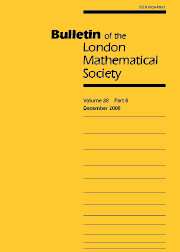Article contents
EXTENDING THE CATEGORY OF LINEARLY ORDERED SPACES
Published online by Cambridge University Press: 01 May 1997
Abstract
1. Ordered spaces
Risking semantic incoherence, we propose in this paper to use the term ordered space to mean any totally ordered set X equipped with a topology [Tscr ], while retaining the term linearly ordered space for its usual role of denoting the special case in which [Tscr ] is the order topology: the topology generated by the order-open initial and final segments of X.
The categories that we shall consider are full subcategories of the category OrdTop of ordered spaces and order-preserving continuous maps. It is easy to see that — in contrast to the situation in the full subcategory LinOrdTop of linearly ordered spaces — every inverse spectrum in OrdTop has a limit and that OrdTop admits subspaces and quotient spaces. These limits, subspaces and quotient spaces are all constructed precisely as in the category Top and are given their naturally induced orderings: where, however, we note that, for the ordered space X to induce an ordering on a quotient space, the quotient space (construed as a decomposition) must partition X into intervals rather than into arbitrary subsets. (In the terminology of [1], these constructions define subspaces and quotient spaces in OrdTop as, respectively, the domains and codomains of extremal monomorphisms and epimorphisms.) The purpose of the paper is to identify the closures of LinOrdTop under these constructions.
- Type
- Research Article
- Information
- Copyright
- © The London Mathematical Society 1997
- 1
- Cited by


